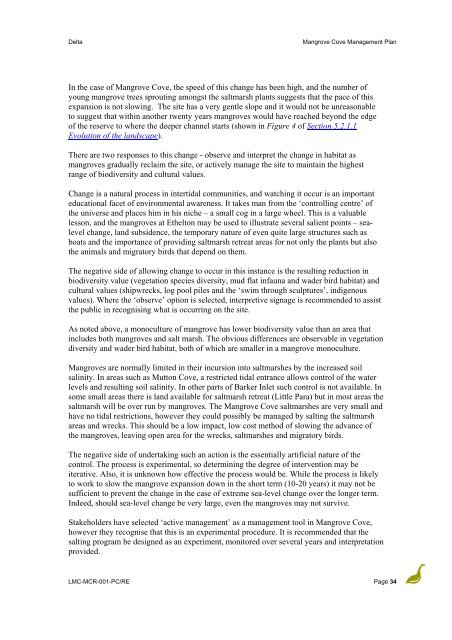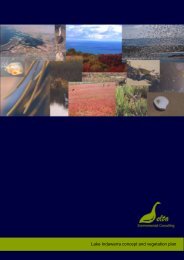Mangrove Cove
Environmental Management Plan for Mangrove Cove - Delta ...
Environmental Management Plan for Mangrove Cove - Delta ...
- No tags were found...
You also want an ePaper? Increase the reach of your titles
YUMPU automatically turns print PDFs into web optimized ePapers that Google loves.
Delta<br />
<strong>Mangrove</strong> <strong>Cove</strong> Management Plan<br />
In the case of <strong>Mangrove</strong> <strong>Cove</strong>, the speed of this change has been high, and the number of<br />
young mangrove trees sprouting amongst the saltmarsh plants suggests that the pace of this<br />
expansion is not slowing. The site has a very gentle slope and it would not be unreasonable<br />
to suggest that within another twenty years mangroves would have reached beyond the edge<br />
of the reserve to where the deeper channel starts (shown in Figure 4 of Section 5.2.1.1<br />
Evolution of the landscape).<br />
There are two responses to this change - observe and interpret the change in habitat as<br />
mangroves gradually reclaim the site, or actively manage the site to maintain the highest<br />
range of biodiversity and cultural values.<br />
Change is a natural process in intertidal communities, and watching it occur is an important<br />
educational facet of environmental awareness. It takes man from the ‘controlling centre’ of<br />
the universe and places him in his niche – a small cog in a large wheel. This is a valuable<br />
lesson, and the mangroves at Ethelton may be used to illustrate several salient points – sealevel<br />
change, land subsidence, the temporary nature of even quite large structures such as<br />
boats and the importance of providing saltmarsh retreat areas for not only the plants but also<br />
the animals and migratory birds that depend on them.<br />
The negative side of allowing change to occur in this instance is the resulting reduction in<br />
biodiversity value (vegetation species diversity, mud flat infauna and wader bird habitat) and<br />
cultural values (shipwrecks, log pool piles and the ‘swim through sculptures’, indigenous<br />
values). Where the ‘observe’ option is selected, interpretive signage is recommended to assist<br />
the public in recognising what is occurring on the site.<br />
As noted above, a monoculture of mangrove has lower biodiversity value than an area that<br />
includes both mangroves and salt marsh. The obvious differences are observable in vegetation<br />
diversity and wader bird habitat, both of which are smaller in a mangrove monoculture.<br />
<strong>Mangrove</strong>s are normally limited in their incursion into saltmarshes by the increased soil<br />
salinity. In areas such as Mutton <strong>Cove</strong>, a restricted tidal entrance allows control of the water<br />
levels and resulting soil salinity. In other parts of Barker Inlet such control is not available. In<br />
some small areas there is land available for saltmarsh retreat (Little Para) but in most areas the<br />
saltmarsh will be over run by mangroves. The <strong>Mangrove</strong> <strong>Cove</strong> saltmarshes are very small and<br />
have no tidal restrictions, however they could possibly be managed by salting the saltmarsh<br />
areas and wrecks. This should be a low impact, low cost method of slowing the advance of<br />
the mangroves, leaving open area for the wrecks, saltmarshes and migratory birds.<br />
The negative side of undertaking such an action is the essentially artificial nature of the<br />
control. The process is experimental, so determining the degree of intervention may be<br />
iterative. Also, it is unknown how effective the process would be. While the process is likely<br />
to work to slow the mangrove expansion down in the short term (10-20 years) it may not be<br />
sufficient to prevent the change in the case of extreme sea-level change over the longer term.<br />
Indeed, should sea-level change be very large, even the mangroves may not survive.<br />
Stakeholders have selected ‘active management’ as a management tool in <strong>Mangrove</strong> <strong>Cove</strong>,<br />
however they recognise that this is an experimental procedure. It is recommended that the<br />
salting program be designed as an experiment, monitored over several years and interpretation<br />
provided.<br />
LMC-MCR-001-PC/RE Page 34



